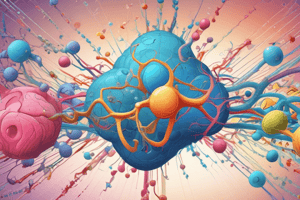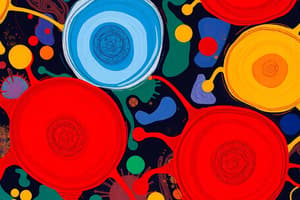Podcast
Questions and Answers
What is the main purpose of cell signaling?
What is the main purpose of cell signaling?
The main purpose of cell signaling is to ensure that cells communicate with each other, function as a cohesive unit, respond to their environment, and adapt to changes.
Describe the process of signal transduction pathways.
Describe the process of signal transduction pathways.
Signal transduction pathways involve a cascade of molecular events initiated by the binding of a signaling molecule to a receptor protein on the cell's surface, leading to a cellular response.
What are the three main types of signal transduction pathways mentioned in the text?
What are the three main types of signal transduction pathways mentioned in the text?
The three main types of signal transduction pathways are G-protein coupled receptor (GPCR) pathways, Tyrosine kinase receptor (RTK) pathways, and Nuclear receptor pathways.
How do G-protein coupled receptor (GPCR) pathways function?
How do G-protein coupled receptor (GPCR) pathways function?
What is the key feature of Tyrosine kinase receptor (RTK) pathways?
What is the key feature of Tyrosine kinase receptor (RTK) pathways?
How do Nuclear receptor pathways regulate cellular processes?
How do Nuclear receptor pathways regulate cellular processes?
What are the components of signal transduction pathways?
What are the components of signal transduction pathways?
How are signaling molecules activated and deactivated?
How are signaling molecules activated and deactivated?
What are feedback loops in signal transduction pathways?
What are feedback loops in signal transduction pathways?
How do signal transduction pathways influence cell growth and proliferation?
How do signal transduction pathways influence cell growth and proliferation?
What role do signaling pathways play in apoptosis (programmed cell death)?
What role do signaling pathways play in apoptosis (programmed cell death)?
How do signaling pathways contribute to cell differentiation?
How do signaling pathways contribute to cell differentiation?
Flashcards are hidden until you start studying
Study Notes
Cell Signaling: A Deeper Look at Signal Transduction Pathways
Cell signaling is a fundamental process through which cells communicate with each other, ensuring that they function as a cohesive unit, respond to their environment, and adapt to changes as needed. This vital exchange of information is facilitated by a complex series of events involving signal transduction pathways, which serve as the backbone of cell signaling.
Signal Transduction Pathways: A Primer
Signal transduction pathways involve a cascade of molecular events initiated by the binding of a signaling molecule, such as a hormone, neurotransmitter, or growth factor, to a receptor protein on the cell's surface. This interaction triggers a sequence of events that ultimately results in a cellular response.
There are several types of signal transduction pathways, including:
- G-protein coupled receptor (GPCR) pathways: These pathways involve G-proteins that relay signals from receptors on the cell's surface to intracellular signaling molecules.
- Tyrosine kinase receptor (RTK) pathways: These pathways involve receptor proteins whose activation by ligand binding triggers the autophosphorylation of their intrinsic tyrosine kinase domains, which then recruit other signaling molecules to initiate a cascade.
- Nuclear receptor pathways: These pathways involve ligand-activated nuclear receptor proteins that function as transcription factors to regulate gene expression.
- Receptor serine/threonine kinase (RSTK) pathways: These pathways involve receptor proteins with serine/threonine kinase activity that become activated upon ligand binding, leading to a cascade of events.
Components of Signal Transduction Pathways
Several key players are involved in signal transduction pathways, including:
- Receptors: These are proteins found on the cell surface, such as GPCRs or RTKs, that bind to signaling molecules.
- Adaptor proteins: These proteins act as scaffolds, helping to bring signaling molecules together and facilitate interactions.
- Signaling molecules: These include enzymes, such as kinases, phosphatases, and G-proteins, that relay signals and amplify or attenuate signaling events.
- Second messengers: These are signaling molecules produced within the cell, such as cyclic AMP (cAMP), calcium ions (Ca2+), or phosphoinositides, that help to amplify and propagate signals.
Regulation and Feedback
Signaling pathways are tightly regulated to ensure appropriate responses to specific stimuli. Regulatory mechanisms include:
- Activation and deactivation: Signaling molecules can be activated by ligand binding or enzymatic modification and deactivated by phosphatases or other mechanisms.
- Feedback loops: Feedback loops, either positive or negative, help maintain homeostasis by regulating the activity of signaling molecules and pathways.
Signal Transduction Pathways in Action
Signal transduction pathways play crucial roles in various cellular processes, including:
- Cell growth and proliferation: Signaling pathways regulate cell cycle progression and the commitment of cells to divide.
- Apoptosis (programmed cell death): Signaling pathways control the initiation and execution of apoptosis, ensuring that cells are removed when they are damaged or no longer needed.
- Differentiation: Signaling pathways help cells develop into specialized cell types with specific functions.
- Migration: Signaling pathways regulate cell movement and migration during development and in response to injury.
Conclusion
Cell signaling is a dynamic process that involves complex interactions between signaling molecules and pathways. Understanding these fundamental processes is essential for deciphering how cells respond to their environment and adapt to changes. This knowledge is also crucial for developing new therapeutic strategies to treat diseases, such as cancer, that involve aberrant signaling pathways. With continued research, we will no doubt uncover even more fascinating aspects of cell signaling and signal transduction pathways, furthering our understanding of the complex communication that occurs within and between cells.
Studying That Suits You
Use AI to generate personalized quizzes and flashcards to suit your learning preferences.




